|
Cardiovascular Laboratory |
Blood Pressure> Background
Information |
| |
Blood pressure can be measured by
several techniques. The direct method (refer to the diagram
below) involves
directly inserting a tube or catheter into a blood vessel. The catheter is connected
to a blood pressure transducer, which generates an electrical signal. |
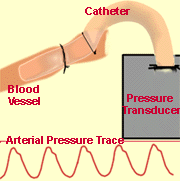 |
In this experiment, we
measure the arterial blood pressure using two different methods. Both of these
methods are indirect, in that they do not involve inserting a catheter directly into the
artery and connecting that catheter to a blood pressure transducer.
The first method uses the sense of touch: it is thus called
the palpatory method.
The second method uses the sense of hearing: it is thus called the auscultatory
method. |
|
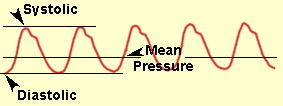
|
The figure to the left shows
a typical tracing of the blood pressure recorded from an artery using the direct
method. The maximum pressure is called the
systolic pressure; the minimum
pressure is called the
diastolic pressure. The pulse pressure
is the difference between the systolic and diastolic pressures. The mean
pressure is given approximately by the sum of the diastolic pressure and one
third of the pulse pressure. |
A sphygmomanometer, an instrument that
measures pressure, is needed in both methods. Each sphygmomanometer consists of a
cuff (containing a "bladder") which is connected by lengths of tubing to an inflating bulb with a needle valve and
to an aneroid pressure gauge.
An appropriately sized cuff covers 2/3 of the biceps; the bladder is
long enough to encircle >80% of the upper arm, and bladder width equals
at least 40% of the upper arm's circumference. |
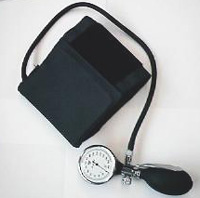 |
Correct positioning of the cuff
The centre of the sphygmomanometer bladder should be placed over the
brachial artery.
Many cuffs have some sort of marking scheme so that placement over the
brachial artery - under, or just medial to, the biceps tendon - is
facilitated. The lower border of the cuff should be ~2cm proximal
to the antecubital fossa and the cuff should be firmly wrapped around
the arm. |
 |
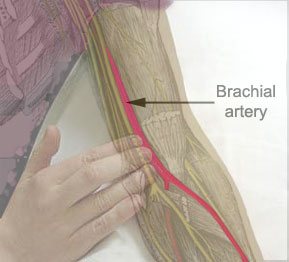 |
|
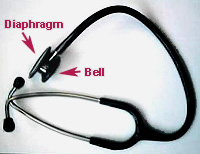
|
|
|
In addition, a stethoscope is needed for
the auscultatory method. Note that the chestpiece of the stethoscope has both a
bell and a diaphragm. |
|
To continue with the next section:
Palpation Method, click here |